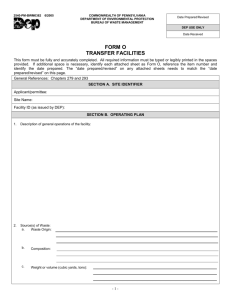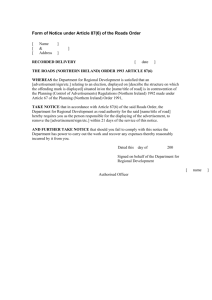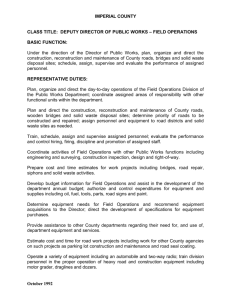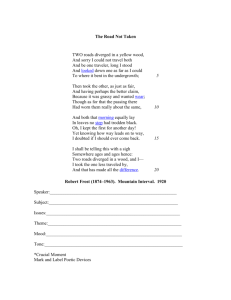concept - World Bank
advertisement
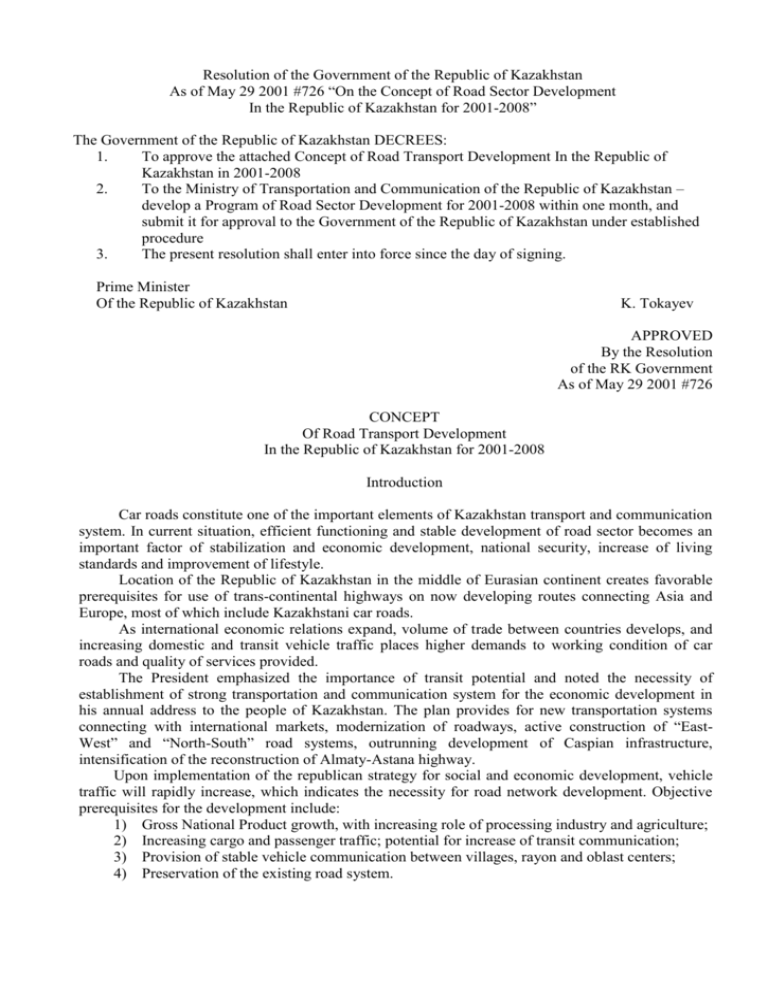
Resolution of the Government of the Republic of Kazakhstan As of May 29 2001 #726 “On the Concept of Road Sector Development In the Republic of Kazakhstan for 2001-2008” The Government of the Republic of Kazakhstan DECREES: 1. To approve the attached Concept of Road Transport Development In the Republic of Kazakhstan in 2001-2008 2. To the Ministry of Transportation and Communication of the Republic of Kazakhstan – develop a Program of Road Sector Development for 2001-2008 within one month, and submit it for approval to the Government of the Republic of Kazakhstan under established procedure 3. The present resolution shall enter into force since the day of signing. Prime Minister Of the Republic of Kazakhstan K. Tokayev APPROVED By the Resolution of the RK Government As of May 29 2001 #726 CONCEPT Of Road Transport Development In the Republic of Kazakhstan for 2001-2008 Introduction Car roads constitute one of the important elements of Kazakhstan transport and communication system. In current situation, efficient functioning and stable development of road sector becomes an important factor of stabilization and economic development, national security, increase of living standards and improvement of lifestyle. Location of the Republic of Kazakhstan in the middle of Eurasian continent creates favorable prerequisites for use of trans-continental highways on now developing routes connecting Asia and Europe, most of which include Kazakhstani car roads. As international economic relations expand, volume of trade between countries develops, and increasing domestic and transit vehicle traffic places higher demands to working condition of car roads and quality of services provided. The President emphasized the importance of transit potential and noted the necessity of establishment of strong transportation and communication system for the economic development in his annual address to the people of Kazakhstan. The plan provides for new transportation systems connecting with international markets, modernization of roadways, active construction of “EastWest” and “North-South” road systems, outrunning development of Caspian infrastructure, intensification of the reconstruction of Almaty-Astana highway. Upon implementation of the republican strategy for social and economic development, vehicle traffic will rapidly increase, which indicates the necessity for road network development. Objective prerequisites for the development include: 1) Gross National Product growth, with increasing role of processing industry and agriculture; 2) Increasing cargo and passenger traffic; potential for increase of transit communication; 3) Provision of stable vehicle communication between villages, rayon and oblast centers; 4) Preservation of the existing road system. On the long run, modernization of road transport is set among the most important priorities in the Presidential Address to the People of Kazakhstan: “Kazakhstan – 2030: Prosperity, Security and Improvement of Lifestyle for all Kazakhstanis”. Road transport development is a complex multilateral issue that requires thoroughly developed state policy in the road sector area, based on actual influence of the road factor on social and economic processes in the republic, and takes comprehensive approach and application of program methods of decision-making. 1. Current condition of the road transport in Kazakhstan In Kazakhstan car roads are being prevailing, and even, for many regions, the only available way of cargo and passenger transportation. Total length of car roads in Kazakhstan comprises 128 th. kilometers. Out of these, 85.6 th. kilometers are general use roads, and 42.4 th.km – departmental (service) roads. General use car roads are divided by republican and local roads. Currently total length of republican car roads comprises 23011km. Within the republican network, approximately 13 000 kilometers belong to international corridors, included into subregional Asian and European transportation network (ESCATO, TRACEA, CIS international roads). Even though republican roads comprise only 27% of the general use roads, they carry more than 50% of overal vehicle traffic. Development of the general use road transportation network in the Republic is basically completed. To finish it, roads connecting with neighboring countries (Beyneu-Nukus, KzylordaUchkuduk, Uzunagash-Bystrovka (Kemin), several exits to Russia) shall be constructed. However, direct communication between Western and Central Kazakhstan is still missing; the shortest route here would be the one between Karabytak and Torgay. As for the technical condition, most of the general use roads have black pavement (asphaltconcrete or black sandstone) – 65.4%, gravel or sandstone – 29.3%. 4,580 kilometers of roads (5.3%) are dirt roads with no pavement. General use roads (km) Share (%) Including, republican roads Share (%) Technical condition of roads Total By types of pavement AsphaltBlack Gravelconcrete gravel sandstone 85647 11724 4256 25087 100 13.7 51.7 29.3 23011 5616 15326 1759 100 24.4 66.6 7.7 Dirt roads 4580 5.3 310 1.3 Quality level of republican roads is slightly above average – 91% of the roads has black pavement, 7.7% -- gravel, 1.3% -- dirtroad gaps. Most of the roads (86%) is of II or III category. This type of roads has two roadways, 7-8 meters wide. Car roads of first category (4 roadways) comprise 685 kilometers – mainly around oblast centers and large localities. Significant part of general use roads (29.3%), including 1,759 kilometers of republican roads, has transitional type of pavement (gravel and sandstone),. 4,580 kilometers of roadways have no pavement (ground roads), including 310 kilometers of republican roads. These roads do not satisfy neither speed requirements, nor load and safety standards. Main problem or road transport is the rapid deterioration of road pavement load capacity. Most of the car roads (86%) were designed and built in 1960-80th, according to the normatives of that period, when axial load did not exceed 6 tons. At present time acceptable axial load is increased to 10 tons. However, certain transport vehicles exceed these limits and destroys the road pavement. Technical inspection as of fall 2000 indicated that 5,348 kilometers (23% of the pavement) on the republican car roads are in the stage of deterioration and have dangerous defects. Only during the last year the length of such roads increased by 322 kilometers. Number of dangerous sections increased by more than 6 times as compared to 1993. It indicates overall worsening of maintenance level. Overall, only 20% of republican car roads can be deemed firm and flat. This is 2.5-3 times less than the similar indicator for federal roads in Russia. Length of local car roads in the republic is equal to 64034 kilometers (77% of general use roads). They serve as a source of initial cargo and passenger traffic. More than half of local car roads (59%) has black pavement, 22,277 kilometers (35%) – gravel and sandstone, and 3,970 – dirt roads. At present time all rayon centers and 90% rural localities have access roads with hard pavement. The others have only dirt roads, and are practically isolated during spring and fall flood. Bridges. General use car roads are connected by more than 3000 bridges and tunnels. 95% of them are heavy-duty, the others are wooden. As the inspection indicated, out of 947 bridges located on republican roads, 212 (22%) are in unsatisfactory condition. Their reliability is secured only on 80%. 62 bridges are in emergency condition with capacity less than 50% of designed, and can be operated only under special passage conditions. Significance of roads International corridors Others: Republican Local Bridges on car roads Bridges (more than 100 running meters) Number Total length (r.m.) 61 12067 Other bridges Number Total length (r.m.) 670 21173 18 - 351 2118 2812 - 16775 68882 In general, bridges are being in unsatisfactory or even in emergency condition; most of them have been built in 1957-1965, and therefore have exhausted their useful life. Overall trend is that every year, 10-15 bridges on republican roads transfer from unsatisfactory into emergency condition, due to excessive workload and lack of necessary maintenance. Condition of bridges Number/r.m. Roads Republican Incl., 6 main routes Local Good& satisfactory 813 274/11469 1419/50398 Unsatisfactory 224 131/6210 620/15570 Emergency 63 36/4796 79/2914 More than 30% of bridges do not comply with roadway standards, which jeopardizes road safety. Funding of roadway maintenance. Steady trend towards deterioration of roadway network is directly connected with unstable funding of road sector. In 1992 expenditures on road transport were equal to US $798.1 million; in 1994-95 they dropped down to US $50 million, in 2000 they went up to US $102 million, and in 2001 they are budgeted in the amount equal to US $160 million. It should be noted, that 90-95% of the repair required every year is not done due to lack of funding. For instance, in Kazakhstan before 2001 spending per one kilometer of car roads did not exceed US $1.6 thousands. In Russia this indicator is equal to US $8.3 thousands, Byelorussia – 7.5 thousands, in Uzbekistan – 4.7 thousands. In developed countries, such as the USA, Germany, or Japan, spending per one kilometer of car roads exceeds US $17 thousands. Kazakhstan plans to increase spending up to the level of Russian Federation Insufficient funding of car roads leads to significant unproductive costs for roar transport. Besides, Kazakhstan loses its transit capacity. The present situation occurred not only due to economic problems within the state, but also because of underestimation of the role of road sector in the economy. One of the ways for solving the funding problem for road ways is the gradual transfer (as the economy and living standards of population increase) towards Road User Cost-Recovery system, consistent with international practice. Transit capacity of roadways in the Republic of Kazakhstan. In 1998 transit traffic comprised 48,914 foreign heavy load vehicles, while in 1999 it went down to 34,698. This trend went on in 2000, which indicates overall reduction of transit traffic due to deterioration of roadways and other unfavorable conditions. At present time, factors of speeding up and regularity of cargo delivery by road vehicles have significant importance. Therefore, producers (and others) rely on road ways not only for short routes, but also for long destinations. Analysis of existing cargo traffic in the Republic of Kazakhstan indicated six main corridors: I. Tashkent-Shymkent-Taraz-Bishkek-Almaty-Horgos (the “Silk Way”); II. Shymkent-Kzylorda-Aktubinsk-Uralsk-Samara; III. Almaty-Karaganda-Astana-Petropavlovsk; IV. Astrakhan-Atyrau-Aktau-Turkmenistan border; V. Omsk-Pavlodar-Semipalatisk-Maykapshagay; VI. Astana-Kostanay-Chelyabinsk. Total length of six transit roadways is equal to 8,258 kilometers. Out of them, 2,982 kilometers are in unsatisfactory condition, and 5,276 – in unsatisfactory. Characteristics of the corridors Length Condition (km) Satisfactory Unsatisfactory Tashkent-Shymkent-Taraz-Bishkek1137 267 870 Almaty-Horgos Shymkent-Kzylorda-Aktubinsk2048 607 1441 Uralsk-Samara Almaty-Karaganda-Astana1669 844 825 Petropavlovsk Astrakhan-Atyrau-Aktau1420 312 1108 Turkmenistan border Omsk-Pavlodar-Semipalatisk1105 600 505 Maykapshagay Astana-Kostanay-Chelyabinsk 879 352 527 Route Traffic intensity (vehicles per day) 4567 1227 2599 757 900 2376 Development of transport corridors increases international importance of renovation of historical centers of the “Silk Way” in the Republic of Kazakhstan. Renewed “Silk Way” passes along the Tashkent-Shymkent-Taraz-Bishkek-Almaty-Horgos roadway with total length of 1137 kilometers. Transit through the territory of the Republic of Kazakhstan consists mainly of vehicles moving between the republics of Central Asia and Russia. Environmental impact. Several main roadways on exits to large localities suffer from traffic overload. Vehicle traffic has significant negative impact on the environment. Due to reduction of speed on sections with unsatisfactory condition, and in places of traffic jam, the volume of CO2 emission increases by several times as compared to the volume of emission on roads with optimum speed. Especially negative impact on the environment occurs within localities. Several intersections at one level, vehicles parked by roadsides, chaotic pedestrian traffic lead to unstable, maneuvering vehicle traffic with varying speed, which causes multiple increase of exhaustion and noise level, and creates accidents. Anti-noise fences are completely absent, the number of traffic lights and proper pedestrian ways is insufficient. These factors cause inconvenience for people living by roadways, and increase sickness rate among them. Aforementioned problems of road sector indicate the necessity for improvement of the state regulation system for the sector, as well as for provision of adequate funding and development of proper legal base. 2. Goals and Objectives of the Concept. 3. Goal of the Concept is the establishment of basis for development of state policy in the area of road sector, maintenance and modernization of roadway network, setting of development priorities, establishment of stable financial basis and necessary legal base, consistent with the recent and future directions of the state road policy. To achieve the goal, the Republic of Kazakhstan shall accomplish the following objectives: 1) Provide adequate funding for road sector improvement activities; 2) Maintain and develop the existing roadway system, improve of the condition thereof; bring the main transit routes into compliance with technical requirements; 3) provide more favorable and secure conditions for domestic and international carriers in the Republic of Kazakhstan; 4) intensify development of the existing main transit highways, and continue to develop possible alternative projects, allowing to increase potential for entering into world markets; 5) attract domestic and international investors for development of road infrastructure on transit highways; 6) establish legal base for private and paid car roads; 7) improve rules and regulations with regard to the road sector. 4. Ways and mechanisms for accomplishment of the Goals and Objectives. 4.1 Secure funding of activities for improvement of car roads. The amount of budget funds necessary for the road sector in 2002-2005 will be adjusted in process of planning and development of the Republican budget for relevant financial year, to provide sufficient funding for the sector. Taking into account existing budget constraints, the sector will continue looking for alternative sources of funding in accordance with the legislation, including domestic and international investments in the repair and construction of highways. 4.2 Maintain and develop the existing network of car roads, improve condition thereof and bring the main transit routes into compliance with technical requirements. To maintain and develop the existing road network, the following will be continued: recovery of devastated sections of highways, reconstruction of bridges in emergency condition, starting from those connecting international routes; liquidation of dirt gaps on roads; road construction on perspective directions. In order to accomplish these, implementation of new technologies is required, alongside with the research and development in the sector, technical modernization, and division of the sector by state and private parts. One of the priority directions is to improve the quality of repair and construction works. The central element thereof is the establishment of an efficient system for construction and repair quality management, as well as control and analysis of the technical condition of roads. Development of the system shall be based on the set of organizational tasks, including: Development and improvement of the system of technical normatives for car roads and road works, including drafting and approval of the normatives, as a result of the research performed by the CIS Interstate Council of Road Sectors, as well as within the republican programs; Development of information system to provide management and control over the condition of car roads; Development of road works quality control system, including metrological provision by means of establishment of quality laboratories in each region, within local subdivisions of the Road Committee. Improvement of certification system for raw materials, inventory and technologies. Quality control system in road sector shall be based on the system of technical normatives, setting progressive norms, rules and requirements, as well as on rigid control of compliance with these norms on all stages, from planning to construction and maintenance. 4.3 provide more favorable and secure conditions for domestic and international carriers in the Republic of Kazakhstan. Car roads, servicing concentrated cargo traffic, including international routes, shall provide sufficient benefits by means of speeding up cargo and passengers delivery, provision of cargo and road safety, establishment of conditions for normal work and rest of road users. This objective shall be accomplished through the improvement of technical conditions of highways, and development of service objects. 4.4 intensify development of existing main transit highways, and continue to develop possible alternative projects, allowing to increase potential for entering into world markets. Development of existing main transit highways and new entrances into world markets will be intensified through participation and joining to international treaties and agreements in the area of road transport. 4.5 Attract domestic and international investors for development of road infrastructure on transit highways. Development of modern highway network requires an improvement of cargo and passenger service through the establishment of necessary conditions for cargo safety, normal work and rest of road users, as well as for the development of road tourism. Road sector funding system and the state policy for development and support of medium and small businesses divide road service objects into two groups, to be constructed and funded from different sources, with separate organizational and legal treatment. The first group of objects comprises those included into the road complex: emergency communication, short-term parking lots, bus stops, car pavilions. The second group comprises paid service objects (motels, campings, gas stations, technical maintenance stations, catering points, terminals, etc.), working as small business enterprises with own means of development. Establishment and development of these enterprises will be determined by the level and supply and demand, and supported by favorable treatment from the government. 4.6 Establish legal base for private and paid car roads. Establishment of paid roads, bridges and tunnels is one of the sources of funding of road sector development, as well as of improvement of services rendered to road users. One of the main sources of road sector development, alongside with attraction of investment from banks, insurance companies and other financial institutions for road building and reconstruction, is the establishment of paid road objects, to attract investment from road users. Existing car roads, bridges and tunnels, as well as those being in process of construction and new construction objects, can be deemed as paid objects. Establishment of paid roads, bridges and tunnels should be made possible only in case if free alternative passage is available in this direction. The amount of fee shall be based on the level of increased convenience, and the amount of benefit acquired by road users through increase of speed, reduction of traffic cost, time and gas spent, as well as increase of road safety. Establishment and maintenance of private and paid highways and road objects require the development of appropriate rules and regulations. 4.7 Improve rules and regulations with regard to the road sector. Road sector reform requires modernization and development of rules and regulations in the area of road sector, namely the improvement of normatives regulating road sector activities, authority of central and local executive bodies, as well as rights and responsibilities of legal entities and individuals participating in establishment and development of general use highways, in accordance to the following general principles: equal access to the road network, economic efficiency of the road sector, implementation of social functions of car roads. The Law of the Republic of Kazakhstan “On Road Sector” will serve as a main legal document, intended to determine legal status of car roads, and enforce rights and responsibilities of all organizations, cooperating in process of road sector development and use. Taking into account large volume and multilateral nature of the road sector legal base, and necessity of the unification thereof with international standards, improvement of technical standards and normatives is performed within research and development done by the CIS Interstate Road Sector Council.




